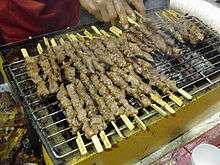Suan cai
| Suan cai | |||||||||||||||||||
|
A tub of Suan cai made from Chinese mustard. | |||||||||||||||||||
| Chinese | 酸菜 | ||||||||||||||||||
|---|---|---|---|---|---|---|---|---|---|---|---|---|---|---|---|---|---|---|---|
| Hanyu Pinyin | suān cài | ||||||||||||||||||
| Literal meaning | sour vegetable | ||||||||||||||||||
| |||||||||||||||||||
| Alternative Chinese name | |||||||||||||||||||
| Chinese | 鹹菜 | ||||||||||||||||||
| Literal meaning | salted vegetable | ||||||||||||||||||
| |||||||||||||||||||
Suan cai (also called suan tsai and Chinese sauerkraut; literally "sour vegetable") is a traditional Chinese pickled Chinese cabbage (napa cabbage), used for a variety of purposes. Suan cai is a unique form of pao cai, due to the ingredients used and the method of production.
An alternative name for suan cai is xian cai (hsien tsai; literally "salted vegetable").
Production

Two distinct types of suan cai are found in China:
- Northern China has used Napa cabbage (Chinese: 大白菜; pinyin: dà bái cài) as the traditional vegetable of choice.
- Southern China uses the thick stalk varieties of Chinese mustard (Chinese: 芥菜; pinyin: jìe cai; Jyutping: syun1 coi3) variety to make suan cai.
Production of suan cai differs from other pao cai in that the vegetable is compressed. This is accomplished by placing a heavy weight such as a large rock on top of the cover of the container so that the Chinese cabbage inside the container is slowly pressed as fermentation takes place. The processing of the vegetable helps to create a distinct flavor.
Suan cai is often used in cooking with meat, especially pork. It is said to neutralize the grease of meat.
Regional
Muslim regions in China and Taiwan
| Part of a series of articles on |
| Chinese Islamic cuisine |
|---|
 |
| Dishes |
In Chinese Islamic cuisine, suan cai can top off noodle soups, especially beef noodle soup.
Hunan
In Hunan, suan cai is frequently made with ginger and chilies (typical of Hunan cuisine).
Guangdong and Hong Kong
In Cantonese cuisine, it is served in a small dish, often as an appetizer, and usually free. Sometimes it can be available in mini-containers on the dining table. There are also Cantonese variations such as salted suan cai (鹹酸菜).
Northeast China

In Northeastern Chinese cuisine, suan cai is made from napa cabbage or head cabbage and has a taste similar to sauerkraut. As part of the cuisine in Manchuria, it is used with dumplings and boiled, or stir fried. More frequently, saun cai is used to make suan cai and pork stew.
Hot pot
In hot pot cuisine, it is often one of the ingredients.
In Thailand
Suan cai has also been incorporated into Thai cuisine, where it is known as phak kat dong (ผักกาดดอง) when only the upper stem and leaf are used'. Most often used in Thai-Chinese dishes, it can also be served as an ingredient in a Thai salad, or as a condiment such as with khao soi, a northern Thai curry-noodle soup. The chopped sour leaf and upper stem is combined with scrambled egg in the dish pak khat dong pat kai. When the dish includes only the main stem and tuber of the cabbage (in the style of zha cai), it is called chee chuan chai in Thai.
Comparison
Suan cai is similar to a fermented-cabbage dish, sauerkraut, which is common in the cuisines of Central and Eastern Europe.
In popular culture
A popular sitcom and namesake song depicting lives in Northeast China, entitled "Cui Hua Shang Suan Cai" (翠花,上酸菜, literally "Cui Hua, serve the suan cai") debuted in 2001, and the phrase Cui Hua Shang Suan Cai became a popular catch phrase. Cui Hua became synonymous with a person from Northeast China. A company in China registered "Cui Hua" brand packaged suan cai.[1]
Possible health hazards of pickled vegetables
The World Health Organization has listed pickled vegetables as a possible carcinogen, and the British Journal of Cancer released an online 2009 meta-analysis of research on pickles as increasing the risks of esophageal cancer. The report, citing limited data in a statistical meta analysis, indicates a potential two-fold increased risk of oesophageal cancer associated with Asian pickled vegetable consumption. Results from the research are described as having "high heterogeneity" and the study said that further well-designed prospective studies were warranted.[2] However, their results stated "The majority of subgroup analyses showed a statistically significant association between consuming pickled vegetables and Oesophageal Squamous Cell Carcinoma".[2]
The 2009 meta-analysis reported heavy infestation of pickled vegetables with fungi. Some common fungi can facilitate the formation of N-nitroso compounds, which are strong oesophageal carcinogens in several animal models.[3] Roussin red methyl ester,[4] a non-alkylating nitroso compound with tumour-promoting effect in vitro, was identified in pickles from Linxian in much higher concentrations than in samples from low-incidence areas. Fumonisin mycotoxins have been shown to cause liver and kidney tumours in rodents.[2]
A 2017 study in Chinese Journal of Cancer has linked salted vegetables (common among Chinese cuisine) to a 4-fold increase in nasopharynx cancer, where fermentation was a critical step in creating nitrosamines, which some are confirmed carcinogens, as well as activation of Epstein–Barr virus by fermentation products.[5][6]
See also
References
- ↑ http://ent.sina.com.cn/cuih.html
- 1 2 3 Islami, F (2009). "Pickled vegetables and the risk of oesophageal cancer: a meta-analysis". British Journal of Cancer. 101 (9): 1641–1647. doi:10.1038/sj.bjc.6605372. PMC 2778505. PMID 19862003. Retrieved 2013-05-14.
- ↑ Li, MH; Ji, C; Cheng, SJ (1986). "Occurrence of nitroso compounds in fungi‐contaminated foods: A review". Nutrition and Cancer. 8 (1): 63–69. doi:10.1080/01635588609513877.
- ↑ Liu, J. G.; Li, M. H. (1989). "Roussin red methyl ester, a tumor promoter isolated from pickled vegetables". Carcinogenesis. 10 (3): 617–620. doi:10.1093/carcin/10.3.617. PMID 2494003.
- ↑ "Study: Salted vegetables increase risk of nose cancer". 16 January 2017. Retrieved 15 February 2018.
- ↑ "Health". Retrieved 15 February 2018.